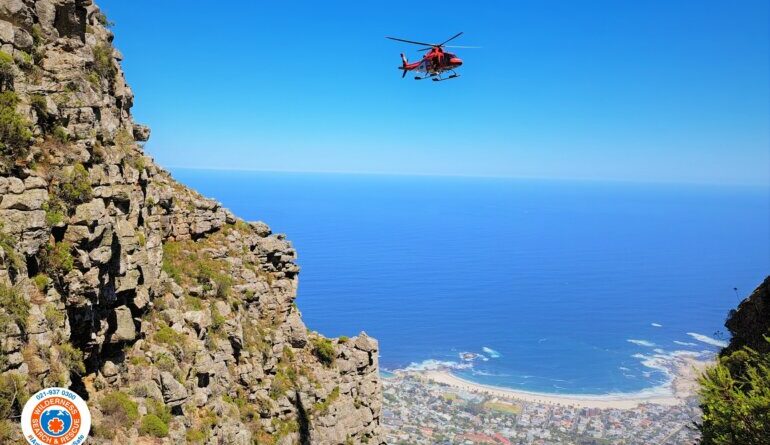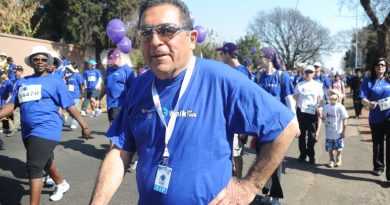Cliff-top rescue high above Camps Bay
• 54-year-old hiker injured while scrambling high above Camps Bay
• Rescue team hoisted down to patient on small, exposed ledge
• Hiker describes how using rescue experience saved critical time
• Outdoor-lovers reminded to save crucial Emergency Number: 021 937 0300
• Please share the #IAmWildernessSafe campaign – to increase safety awareness
A hiker was rescued from a cliff-top ledge high above Camps Bay.
The patient’s location was confined and very exposed, with a 10m cliff below.
Dedicated teams of professionals and volunteers from Wilderness Search And Rescue (WSAR) were called to assist the 54 year-old woman on Saturday morning from Cairn Ravine, the first ravine after the Kloof Buttress, on the Camps Bay side of Table Mountain.
The hiking group had been scrambling up a steep section of the route, when a member misstepped and fell 5 meters backwards, landing on the broken ground below.
Fortunately, her backpack offered some protected, but her shoulder was injured, and she was unable to proceed.
A WSAR team on board the Western Cape Department of Health EMS / Air Mercy Service (AMS) rescue helicopter was immediately dispatched to scene. Once in position, a recue climber and paramedic were hoisted from the helicopter, down to the patient.
The rescue climber immediately constructed a rope safety point, to ensure that the team members and the patient were protected from falling from the ledge.
The patient was packaged into a stretcher and hoisted up into the helicopter, before being flown to a nearby landing zone and handed over to a waiting ambulance. She was driven to hospital.
A member of the hiking group and volunteer Wilderness Search And Rescue member, Fredy Mohorich, describes how using his rescue experience saved critical time and ensured faster medical treatment for his friend.
Cliff-top rescue high above Camps Bay https://t.co/t0Jm1YJn57 #ArriveAlive #Hiking #MountainRescue #AirEvacuation @WSARWesternCape @AIRMERCYSERVICE pic.twitter.com/tzFVnWHCfL
— Arrive Alive (@_ArriveAlive) February 6, 2023
“These are principles every mountain user should know.
1: “Firstly, remain calm. You can’t help anyone if you’re panicked. If you’re calm, the rest of the group will be too.
“Then, declare an emergency and take charge.
2: “Assess the patient. She was injured and we needed help.
3: “Very importantly, know who to call. I and all of my outdoor friends have the WSAR number – 021 937 0300, saved. Call this number first before phoning anyone else.
4: “When you’re talking to the person at the emergency call centre, tell them your name and why you’re calling. Describe the emergency and give the facts, short and to the point. I said that she had fallen, described her injuries and explained that she could not proceed.
5: “Tell them about your environment. We were in a steep ravine, with no easy access.
“Know how to send your location information, or PIN drop when asked to. Send this to someone to communicate on your behalf if necessary.
6: “After the call, manage the scene and the expectations of the rest of the hiking party. Everyone knew that we’d called WSAR and we explained that rescues can take time.
“Look after your patient. We had already made sure that she was safe and couldn’t fall further. We gave her water and made her as comfortable as possible.
7: “Ensure the scene is safe, in anticipation of the rescue. I asked the rest of the group to move to a safer location and ensure that all jackets, hats and other loose items were safely packed away. We understood that the helicopter was going to be used, and these items are a danger to the aircraft.
8: “Finally, allow the rescue team the space to work. It sounds silly, but you need to step back, but be willing to assist if asked to.”
WSAR’s David Nel said: “When reporting any emergency, it’s essential that callers provide clear, appropriate information. Speak clearly and don’t rush the information you’re trying to get across.
This allows the control centre staff to dispatch the appropriate responses quickly, saving valuable time.
“We wish our patients a full recovery and we thank all WSAR members for their continued commitment.
“If anyone reading this does not yet have our number – 021 937 0300 saved on their phone, please do so immediately, and help us to reach others by sharing our posts on the #IAmWildernessSafe campaign.”
• Wilderness Search And Rescue (WSAR) is a network of government agencies, and civilian volunteer organisations, who partner in search and rescue.
Photos provided by Fredy Mohorich and Brent Russel




